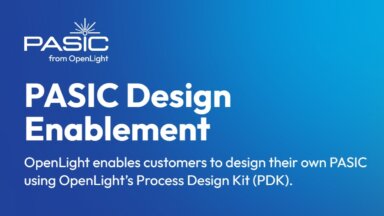
Press releases
How OpenLight and Synopsys are reimagining datacenters through silicon photonics
Steven Alleston, business development director at OpenLight, co-authored this article with Jigesh K. Patel and Keivan Javadi Khasraghi of Synopsys.
Datacenters provide servers, data storage drives, and networking for applications such as artificial intelligence/machine learning (AI/ML), cloud computing, high-performance computing (HPC), quantum computing, and highly automated vehicles. High bandwidth and low latency are required by all these applications. Electronic solutions, including electrical copper interconnects, have reached their bandwidth limit. The future will require photonic solutions using optical interconnects to handle the amount of data and complexity of processing, now required.
Silicon photonics and co-packaged optics (CPO) are just some examples of the increasingly critical role photonics is playing in addressing the future needs of datacenters.
This article looks at optical design, new datacenter architecture, optical modules, and the role of high-speed SerDes interfaces in cloud applications, along with the importance co-simulation in optics and electronics play in optimal engineering solutions. The article goes on to consider the following in more detail:
- How massive workloads are forcing a transformation in datacenter architecture, with tens of thousands of servers operating simultaneously in hyperscale datacenters, demanding high bandwidth, low latency, and low power consumption optical interconnects.
- The role of high-speed SerDes (seriealizer / deserializer) architecture in optical data transfer, facilitating minimal loss over longer distances. Optical module power consumption reduces by 35%, with improved latency, and linear and direct, optical drives, remove inefficient dispersion and nonlinearities, again reducing interconnect power.
- How moving from pluggable to on-board to co-packaged optical interconnects, using silicon photonics, is improving network, power efficiency. How IEEE and OIF are developing interoperability specifications for multi-vendor support and competition in the supply chain.
- How seamless co-design of the electrical and optical components, using electronic/photonic design automation (EPDA) platforms, is critical to achieving first-pass silicon success – including effective simulation and analysis tools, such as SPICE or HSPICE circuit simulators.
Read the full article on the Synopsys website, here...
View the Synopsys and OpenLight electro-optical demonstration video on our website, here...
More Press releases

OpenLight Joins Expert Panel Debating Photonics Manufacturing at PECC Summit 2025
OpenLight will present their unique heterogeneous integration technology in a session dedicated to discussing best practices for the production of…

OpenLight wishes all its customers a merry Christmas and a happy and prosperous New Year.
We would like to thank all our customers for their valued support during 2024, where we saw record growth. We look forward to an exciting 2025.

Customers design PASICs using OpenLight's Process Design Kit.
OpenLight is focused on design enablement to provide customers with everything they need to design their own, bespoke PASIC - Photonic…